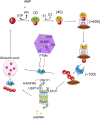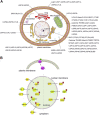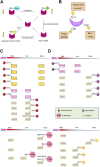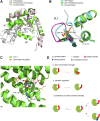Post-Translational Modifications of Deubiquitinating Enzymes: Expanding the Ubiquitin Code
- PMID: 34177595
- PMCID: PMC8224227
- DOI: 10.3389/fphar.2021.685011
Post-Translational Modifications of Deubiquitinating Enzymes: Expanding the Ubiquitin Code
Abstract
Post-translational modifications such as ubiquitination play important regulatory roles in several biological processes in eukaryotes. This process could be reversed by deubiquitinating enzymes (DUBs), which remove conjugated ubiquitin molecules from target substrates. Owing to their role as essential enzymes in regulating all ubiquitin-related processes, the abundance, localization, and catalytic activity of DUBs are tightly regulated. Dysregulation of DUBs can cause dramatic physiological consequences and a variety of disorders such as cancer, and neurodegenerative and inflammatory diseases. Multiple factors, such as transcription and translation of associated genes, and the presence of accessory domains, binding proteins, and inhibitors have been implicated in several aspects of DUB regulation. Beyond this level of regulation, emerging studies show that the function of DUBs can be regulated by a variety of post-translational modifications, which significantly affect the abundance, localization, and catalytic activity of DUBs. The most extensively studied post-translational modification of DUBs is phosphorylation. Besides phosphorylation, ubiquitination, SUMOylation, acetylation, oxidation, and hydroxylation are also reported in DUBs. In this review, we summarize the current knowledge on the regulatory effects of post-translational modifications of DUBs.
Keywords: DUBs; acetylation; hydroxylation; oxidation; phosphorylation; post-translational modifications; sumoylation; ubiquitination.
Copyright © 2021 Wang and Wang.
Conflict of interest statement
The authors declare that the research was conducted in the absence of any commercial or financial relationships that could be construed as a potential conflict of interest.
Figures




Similar articles
-
PTMs in conversation: activity and function of deubiquitinating enzymes regulated via post-translational modifications.Cell Biochem Biophys. 2011 Jun;60(1-2):21-38. doi: 10.1007/s12013-011-9176-6. Cell Biochem Biophys. 2011. PMID: 21480003 Free PMC article. Review.
-
Regulation of Deubiquitinating Enzymes by Post-Translational Modifications.Int J Mol Sci. 2020 Jun 4;21(11):4028. doi: 10.3390/ijms21114028. Int J Mol Sci. 2020. PMID: 32512887 Free PMC article. Review.
-
Deubiquitinating enzymes (DUBs): Regulation, homeostasis, and oxidative stress response.J Biol Chem. 2021 Sep;297(3):101077. doi: 10.1016/j.jbc.2021.101077. Epub 2021 Aug 12. J Biol Chem. 2021. PMID: 34391779 Free PMC article. Review.
-
Recent advances in the development of deubiquitinases inhibitors as antitumor agents.Eur J Med Chem. 2024 Feb 15;266:116161. doi: 10.1016/j.ejmech.2024.116161. Epub 2024 Jan 18. Eur J Med Chem. 2024. PMID: 38262120 Review.
-
Mechanisms orchestrating the enzymatic activity and cellular functions of deubiquitinases.J Biol Chem. 2022 Aug;298(8):102198. doi: 10.1016/j.jbc.2022.102198. Epub 2022 Jun 25. J Biol Chem. 2022. PMID: 35764170 Free PMC article. Review.
Cited by
-
An expanded lexicon for the ubiquitin code.Nat Rev Mol Cell Biol. 2023 Apr;24(4):273-287. doi: 10.1038/s41580-022-00543-1. Epub 2022 Oct 25. Nat Rev Mol Cell Biol. 2023. PMID: 36284179 Free PMC article. Review.
-
Ubiquitination and De-Ubiquitination in the Synthesis of Cow Milk Fat: Reality and Prospects.Molecules. 2024 Aug 29;29(17):4093. doi: 10.3390/molecules29174093. Molecules. 2024. PMID: 39274941 Free PMC article. Review.
-
USP13: Multiple Functions and Target Inhibition.Front Cell Dev Biol. 2022 Apr 4;10:875124. doi: 10.3389/fcell.2022.875124. eCollection 2022. Front Cell Dev Biol. 2022. PMID: 35445009 Free PMC article. Review.
-
Porous Cu-MOF nanostructures with anticancer properties prepared by a controllable ultrasound-assisted reverse micelle synthesis of Cu-MOF.BMC Chem. 2022 Mar 5;16(1):10. doi: 10.1186/s13065-022-00804-2. BMC Chem. 2022. PMID: 35248138 Free PMC article.
-
Significance of Anoctamin 6 in progression and prognostic prediction of gastric adenocarcinoma.Histol Histopathol. 2022 Oct;37(10):1007-1017. doi: 10.14670/HH-18-469. Epub 2022 May 12. Histol Histopathol. 2022. PMID: 35548923
References
Publication types
LinkOut - more resources
Full Text Sources

